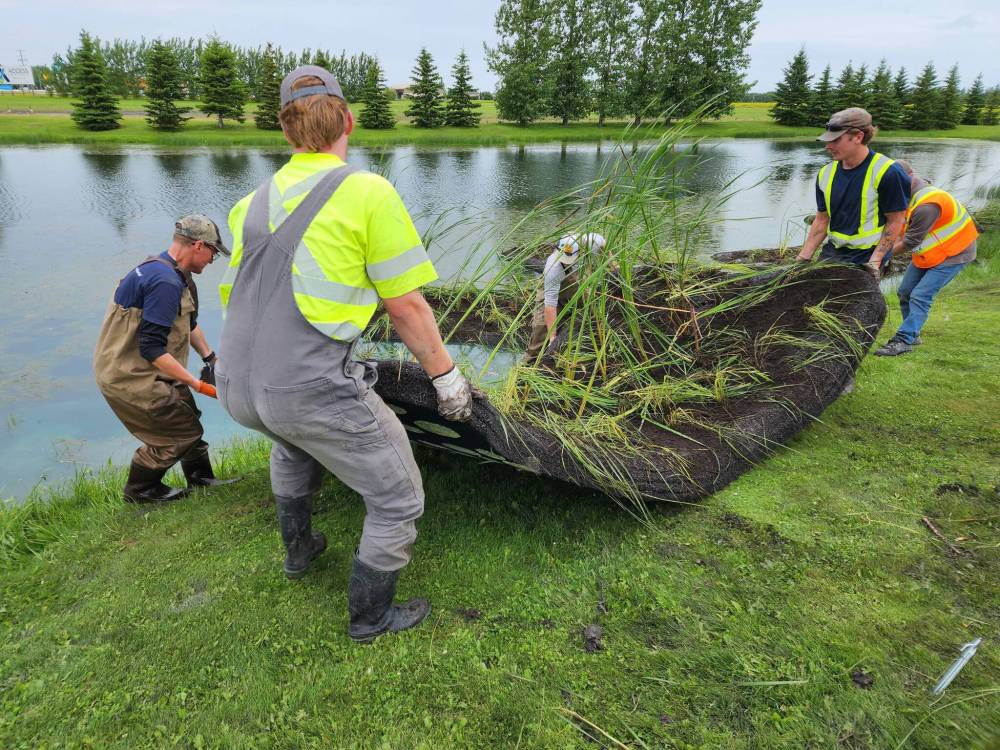Wetlands project propagating past Perimeter
Oakbank follows East St. Paul in installing floating wetlands in retention ponds
Advertisement
Hey there, time traveller!
This article was published 31/07/2024 (428 days ago), so information in it may no longer be current.
An environmental stewardship project that was piloted in East St. Paul is set to spread next door to the R.M. of Springfield.
In July 2021, researchers from the International Institute for Sustainable Development built and planted 10 floating wetlands in two stormwater retention ponds in East St. Paul, with the aim of improving water quality and removing harmful pollutants from the water — the first project of its kind in Manitoba.
Run by IISD’s bioeconomy and water policy lead, Richard Grosshans, the project has proven effective, and new floating wetlands are now being launched in stormwater retention ponds in Springfield.

Supplied photo by Joey Simoes
A crew from the International Institute for Sustainable Development built and installed floating wetlands in stormwater retention ponds in the RM of Springfield recently. The project is similar to one launched in 2021 in the RM of East St. Paul.
“This concept is still very new to Manitoba,” said Grosshans, the bioremediation lead for the IISD. “We’re still learning how (the floating wetlands) function in Manitoba, how they survive our winters and our environments. We want to learn more about these islands and get people excited about them. We want people to learn about them, so we can put in more when see success in these stormwater ponds.”
The R.M. of Springfield and the IISD have been discussing the project over the past couple years, Grosshans said, and last year they secured Environment Canada funding to purchase the islands, which were installed earlier this month. Further funding from the Peter Gilgan Foundation and the B.H.P Foundation will allow the IISD to share the findings and promote the project locally.
“We’ll be able to generate interest in all the benefits and hopefully get people excited about it, so we can do more of these kind of projects,” Grosshans said.
Three years after the launch of the project in East St. Paul, Grosshans said you can see the signs of the wetlands doing their job on the retention ponds.
“It’s been a learning curve for sure,” he said. “The wetlands have grown, some have broken away and moved from their original spots, so we have to do better anchoring. We’ve seen better water quality for sure in the smaller pond, where you can see visual clarity. There has been reduced algae growth in those areas, favouring some of the more beneficial algae, which indicates more of a healthy wetland environment. The larger one has been harder to gauge, but there is a benefit to water. They are producing roots, which indicates a healthy wetland.”
Along with improved water quality, these floating wetlands also provide habitat for animals and organisms in and on the water, contributing to local biodiversity.
“The floating wetlands provide platforms for plants to grow, to provide that biological activity,” Grosshans said. “What they’re doing is they’re competing for the same nutrients that algae needs, taking it away, with the idea that they reduce the amount of algae and improve oxygen in water.”
While the floating wetlands in East St. Paul need some maintenance this year — mostly replanting sedge grasses, as well as re-anchoring some of the islands — Grosshans added that is not out of the ordinary for any infrastructure project.
“This project is part of a larger project we have on natural infrastructure, working with natural systems,” he said. “These islands are natural infrastructure, which we’re trying to use to address environmental challenges.”
Compared to the cost of re-engineering older stormwater retention ponds, Grosshans noted, installing and maintaining floating wetlands is much more economical.
“It can very expensive to re-engineer these ponds, so we have to rely on things like adding these floating wetlands to achieve those goals,” he said. “The City of Winnipeg is really proactive and progressive, in that they require all new stormwater ponds to be a wetland-type of pond. They’ve really embraced that fact that wetlands are better for water quality, air quality, preventing goose nuisance, and they just look nicer. Unfortunately, a lot of older ponds aren’t built that way.”

Sheldon Birnie
Community Journalist
Sheldon Birnie is a reporter/photographer for the Free Press Community Review. The author of Missing Like Teeth: An Oral History of Winnipeg Underground Rock (1990-2001), his writing has appeared in journals and online platforms across Canada, the U.S. and the U.K. A husband and father of two young children, Sheldon enjoys playing guitar and rec hockey when he can find the time. Email him at sheldon.birnie@freepress.mb.ca Call him at 204-697-7112
Our newsroom depends on a growing audience of readers to power our journalism. If you are not a paid reader, please consider becoming a subscriber.
Our newsroom depends on its audience of readers to power our journalism. Thank you for your support.




